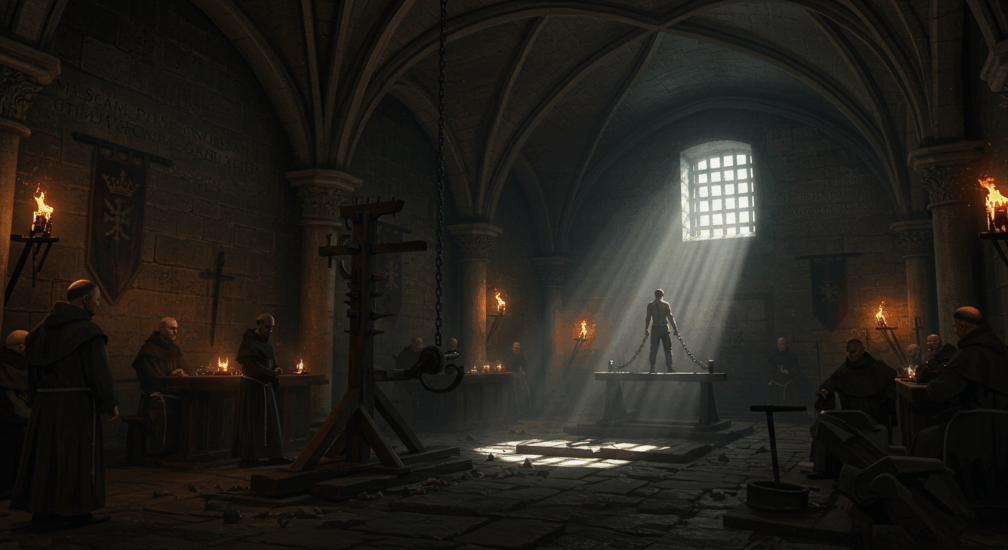In the medieval world, few crimes were seen as more heinous than treason. To betray one’s crown, monarch, or comrades was not just a political offense-it was a spiritual and moral collapse. As a result, the response was often swift, merciless, and agonizing. Torture became a defining tool of justice, both to extract confessions and to punish those whose loyalty had crumbled.
The Crime That Shook Kingdoms
Treason in the Middle Ages wasn’t just about assassination attempts or coup plots. It could be as simple as secrecy-withholding information from the ruling regime-or siding with an enemy during an uprising. The weight of this betrayal fell heavily not only on the accused but also on their families and legacies. Public examples had to be made, and so began a long tradition of traitor trials in the Middle Ages.
Medieval Crime and Punishment
To understand treason, one must first explore the broader scope of medieval crime and punishment. In a time where the rule of law was dictated by divine order and royal whim, punishments often fit not the crime, but the mood of the ruler or the needs of the tribunal. Justice was both a display of power and a deterrent. For those accused of betrayal, the spectacle was especially grim.
What Was the Punishment for Treason in Medieval Times?
What was the punishment for treason in medieval times? The answer: almost always death-but rarely a quick one. The condemned might be dragged to the gallows, dismembered, or boiled alive. Hanging, drawing, and quartering became symbolic of the severity reserved for traitors. Such punishments served as a chilling reminder of the price of treachery.
Medieval Punishment for Treason: From Chains to Fire
Medieval punishment for treason was designed to instill fear. Offenders were often kept in damp dungeons, shackled in chains, and subjected to long periods of starvation and humiliation before the final sentence was carried out. Public executions weren’t only for justice-they were theatrical tools to affirm the power of the crown and suppress dissent.
Medieval Treason Torture Methods
The medieval treason torture methods were as creative as they were cruel. Devices like the Judas Chair, Iron Maiden, and Scavenger’s Daughter weren’t just instruments-they were expressions of state-sanctioned torment. They were designed to break not only the body but also the spirit. The goal was not simply to kill, but to erase the individual and his or her legacy.
Confession Under Torture: Medieval Interrogation Methods
Confession under torture medieval was legally recognized in many kingdoms. People believed that truth could be beaten out of a person-quite literally. Medieval interrogation methods often involved the rack, thumb screws, or the strappado. Prisoners were forced to choose between silence and unbearable pain. Whether such confessions were reliable was of little concern; they were simply a means to an end.
Betrayal Punishment in History: More Than Just Pain
The betrayal punishment history goes beyond Europe. While our focus is on the medieval period, cultures across the globe have responded to treason with severity. Yet in medieval Europe, punishment reflected a deeper need to maintain divine and royal order. The punishment wasn’t just justice-it was a public display meant to restore balance and silence any whispers of rebellion.
Want to See the Tools of Treason Torture?
If this glimpse into the brutal world of medieval justice fascinates you, visit the Medieval Torture Museum in Chicago where real-life replicas of these devices-and the stories behind them-await you.
Planning a trip and wondering where to visit in Los Angeles? Our LA location brings the dark past into a modern immersive space.
Traveling to Florida? Discover our Medieval Torture Museum in St. Augustine-a historical city with a sinister side.
And for more deep dives into history’s darkest corners, visit our regularly updated blog.
Treason may have changed in form over the centuries, but the responses to betrayal in the medieval world remain a haunting testament to the lengths societies will go to protect power, enforce justice, and uphold the fragile line between loyalty and death.






